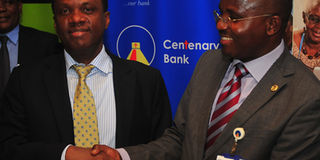Umeme to install 16,000 pre-paid meters

UMEME chairman Patrick Bitature (L) shakes hands with Centenary Bank managing director Fabian Kasi after the launch of the utility payment partnership between the two firms at Mapeera House on Tuesday. Photo BY STEPHEN WANDERA.
What you need to know:
Power distributor wants everybody on new system by 2018.
KAMPALA
By close of the year, at least 16000 new consumers would be connected to the pre-paid meters, electricity distributor Umeme has said.
Umeme general manager Sam Zimbe said this on Tuesday at the signing of a partnership that will see Centenary Bank customers pay power bills on CenteMobile.
With pre-paid meters, it is believed that consumers will not only budget for their power but also pay for what they have actually used as opposed to estimates that have drawn criticisms from consumers for quoting inflated figures—bills.
“By end of this year, we will connect 16000 people to pre-paid meters. And by the end of next year we would have added another 200,000 connections. By 2018 we would have converted into pre-paid meters—everybody will be using pre-paid system,” Mr Zimbe said earlier in the week.
Speaking at the same event, Umeme board Chairman Patrick Bitature said the collaboration may signify the end of its 33 cash-receiving offices. “Our expertise is not in receiving and keeping money. That is the work of the bank,” Mr Bitature said. “We want to concentrate on distributing power throughout the country and not collecting money—something that is not our business,” he added.
Centenary bank Managing Director Fabian Kasi said Centenary bank will provide the service free of charge, meaning that the banks customers will pay their Umeme bills without the bank charging them for that service.
It is also understood that this is the second deal Umeme has signed, the earlier one being with Ezeemoney, a new online payment solution company, where the customers will be able to make payments using electronic money.
Umeme has so far managed to connect more than 50,000 customers onto pre-paid meters as the company continues spending its $440 million for more installations till 2018 when it hopes to fully convert its customers from postpaid meters to pre-paid meters.
The power distributor is looking to emulate Uganda Revenue Authority and National Water and Sewerage Corporation who have moved from paying in hard cash to pre-paid and online/electronic payment.




